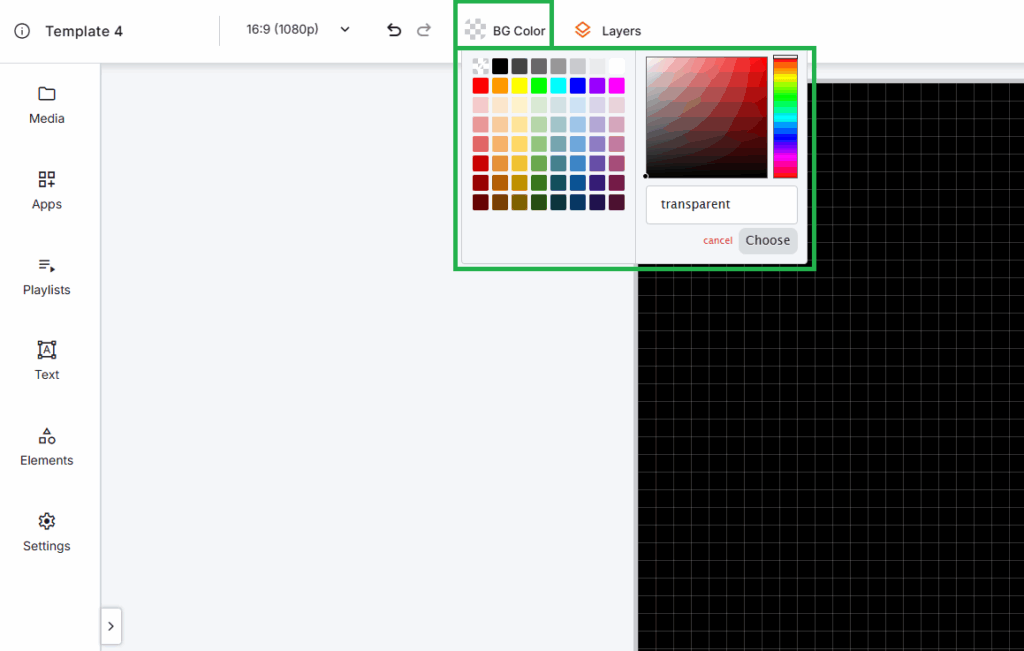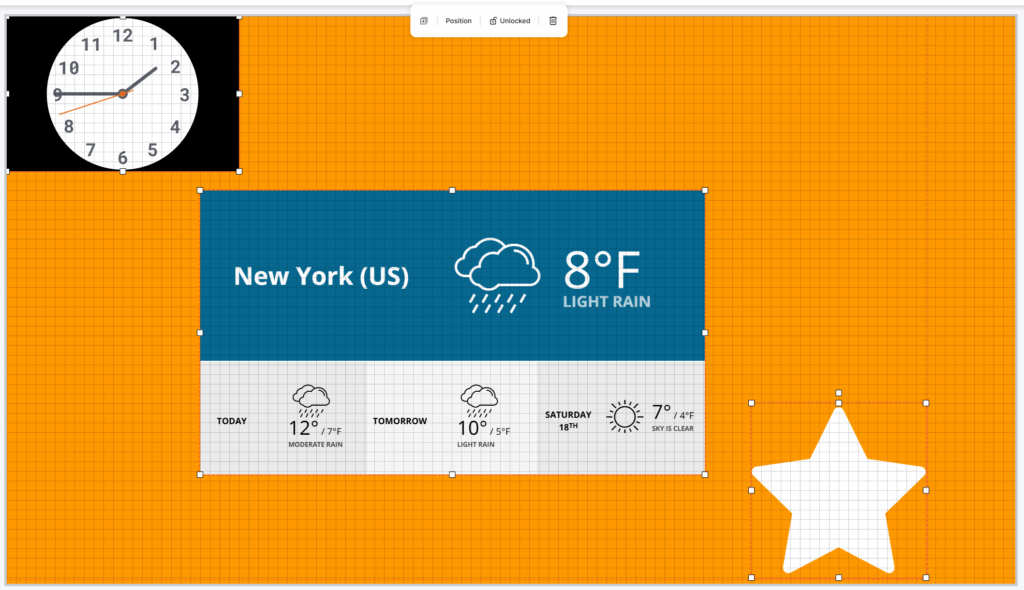Table of Contents
- Overview
- Working with the Contextual Toolbar
- Editing Text Elements
- Editing Media Elements
- Working with Shapes and Clipart
- Customizing Background Color
- Multi-Selection and Bulk Editing
- Best Practices for Editing Layouts
- F.A.Q.s
Overview
Once you’ve created a layout, the next step is customizing it to match your message, brand, and visual style. The redesigned Layout Editor gives you powerful tools to format text, style media, customize shapes, and manage multiple elements, all while staying simple and intuitive.
This guide walks you through the key editing features, from the toolbar to advanced techniques like partial text formatting and multi-selection editing.
Working with the Contextual Toolbar
The Contextual Toolbar is your main editing tool in the Layout Editor. It appears at the top of the canvas frame whenever you select an element and changes based on the type of element selected.
[Screenshot: Toolbar highlighted above the canvas frame with text element selected]
Toolbar Actions Overview
Here’s what you can typically do from the toolbar:
- Duplicate an element (
Ctrl/Cmd + D) - Align and arrange elements
- Change position and size with coordinate inputs
- Lock an element (Premium/Enterprise only)
- Rotate or delete items
- Access type-specific options (like font, stroke, or fitting)
Editing Text Elements
Text elements are one of the most common components in a layout, and the redesigned toolbar makes formatting them quick and precise.

Basic Text Formatting
When you select a text box, the toolbar allows you to:
- Change font and size (with a searchable font dropdown)
- Adjust text color and background color
- Apply bold, italic, and underline (with shortcuts:
Ctrl/Cmd + B,Ctrl/Cmd + I,Ctrl/Cmd + U) - Align text left, center, or right
- Adjust line spacing and text direction
- Adjust the positioning of the component on the levels of the Canvas Frame.
- Duplicate, Lock, Rotate, Delete.
Partial Text Formatting
You’re no longer limited to formatting an entire text box. Now you can style specific words or phrases.
To format part of the text:
- Click the text box to enter edit mode.
- Highlight the portion you want to style.
- Apply formatting from the toolbar.
Supported partial formatting actions:
- Bold, italic, underline
- Font family
- Font size
- Text color
Example: Highlight just the word “SALE” in a sentence and make it bold, red, and larger to emphasize a call-to-action.
⚙️Behavior details:
- If multiple styles exist in the selection, the toolbar shows “Mixed”.
- Formatting is preserved when switching between text boxes, saving, or previewing.
- Copy-pasting from Google Docs, Word, or Notion retains most supported formatting.
💡Pro Tip: Combine partial formatting with dynamic text to create multilingual signage or highlight critical information without separate text boxes.
Editing Media Elements
Media elements, such as images, videos, and webpages, have their own set of customization options.

Key Media Editing Options
- Replace: Instantly swap an image, video, or document without losing its position.
- Pixie Editor: Open images in the platform’s built-in editor for cropping, filters, and more.
- Fitting Options:
- Fill: Scale to fill the frame (may crop edges).
- Fit: Show the entire image (may leave space).
- Stretch: Fill the area (may distort content).
- Transparency: Adjust transparency for overlay effects.
- Position: Adjustments of the component on the levels of the Canvas Frame.
- Duplicate, Lock, Delete: Quickly manage media elements from the toolbar.
Example Scenario: Replace a placeholder image with a new product photo while preserving its size and position. There is no need to reposition or resize manually.
Working with Shapes and Clipart
Shapes and clipart are useful for highlighting important areas or adding decorative elements. These can now be accessed from the new Elements Tab, which also includes a search bar and a “Recently Used” section.

Shape and Clipart Editing Options
- Color & Stroke: Change fill and outline colors.
- Stroke Weight: Adjust line thickness for shapes.
- Flip: Mirror clipart horizontally or vertically.
- Position: Adjustments of the component on the levels of the Canvas Frame.
- Duplicate, Lock, Rotate, Delete: Available for all visual elements.
💡Pro Tip: Use shapes to create backgrounds for text or to group related elements visually.
Customizing Background Color
You can now change the background color of your entire layout with a single click! No more workarounds with full-screen images.
To change the background color:
- Go to the Top Navigation Bar.
- Click the Background Color Picker.
- Choose from a palette or enter a custom HEX/RGB value.

Important Notes:
– Only solid colors are supported (no gradients or patterns).
– The background applies to the entire layout.
– Custom brand colors are supported.
Example Use Case: Quickly update seasonal signage by changing the background from neutral gray to holiday red without rebuilding the layout.
Multi-Selection and Bulk Editing
A major time-saver in the redesigned Layout Editor is the ability to select and edit multiple items at once.
How to multi-select:
- Hold Shift and click on multiple elements.
- Use Ctrl + Shift + Click to deselect one item.

Actions You Can Perform with Multi-Selection
- Duplicate all selected elements
- Align them horizontally or vertically
- Lock or delete them
- Adjust position or transparency in bulk
⚙️Behavior details:
- If even one selected item is locked, the entire selection cannot be moved.
- A tooltip explains why movement is blocked.
- Undo (
Ctrl + Z) reverses the last group action.
Example Scenario: Select three product images and move them as a single group to reposition a product showcase.
Best Practices for Editing Layouts
- Use partial formatting for emphasis instead of creating multiple text boxes.
- Replace media instead of deleting and re-adding it to keep positioning intact.
- Leverage multi-selection for quick adjustments to complex layouts.
- Choose high-contrast background colors for maximum readability.
- Lock elements once final to prevent accidental edits (Premium/Enterprise).
F.A.Q.s
Got questions? We’ve got answers! This section addresses common questions about Editing and Customizing Content in the Layout Editor.
Can I edit text formatting from external documents?
Yes. Pasting from Google Docs, Word, or Notion retains most formatting, such as bold, italics, font color, and size, provided the fonts are supported in the platform.
Why can’t I move multiple elements together?
If any of the selected elements are locked, the entire group can’t be moved. Unlock them first.
Can I apply different fonts to one text box?
Yes. With partial text formatting, you can mix fonts, sizes, and colors within a single box.
Can I change the background color of just one section?
No. The background color applies to the entire layout, but you can simulate sections with shapes or full-width elements.